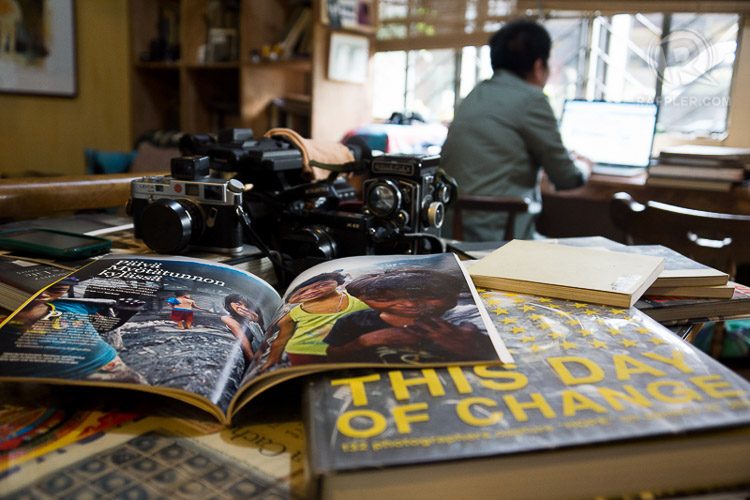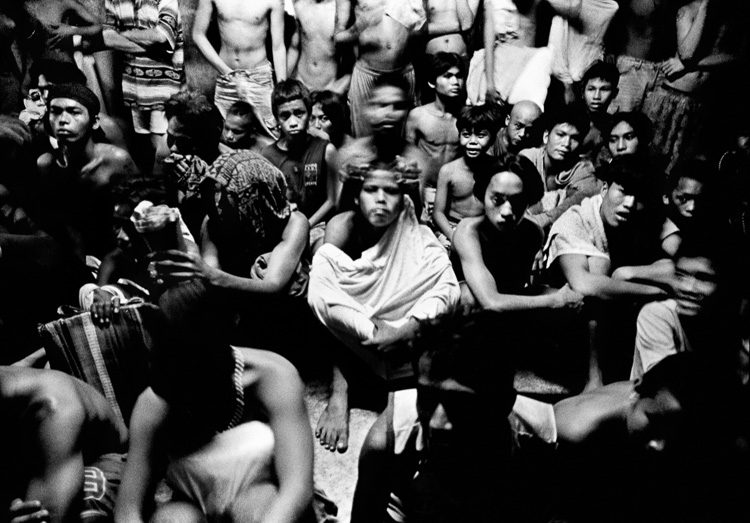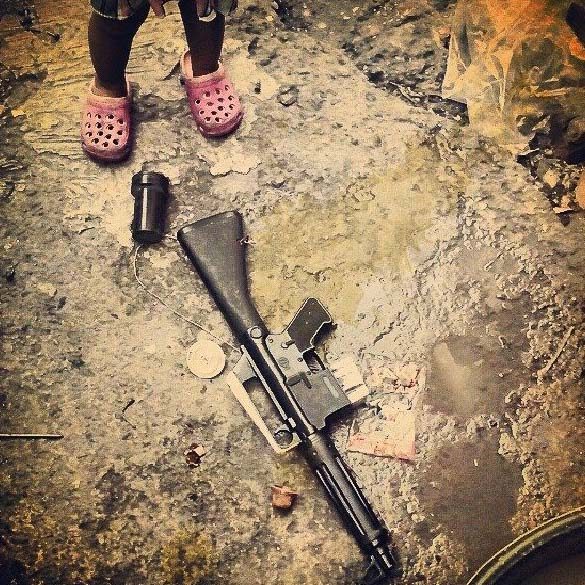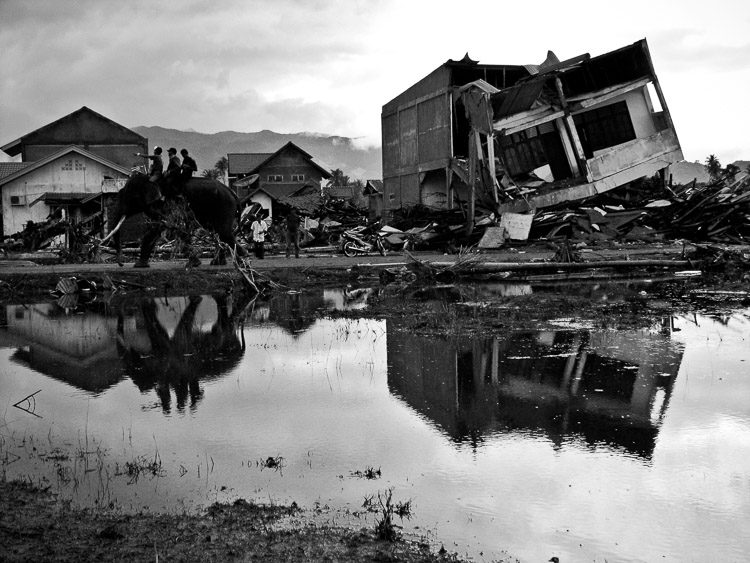SUMMARY
This is AI generated summarization, which may have errors. For context, always refer to the full article.

MANILA, Philippines — Nana Buxani’s work has been shown all over the world. She tackles hard-hitting issues such as poverty, social welfare, child labor, and women’s rights. Her kindness and ability to photograph has earned the trust of her subjects and admiration of photographers both young and old.
Her house also serves as a workplace. Various parts of the walls show her books acquired or given as gifts side by side with the various cameras she has used. The walls are also lined with her other projects such as paintings and sketches. The centerpiece of her house is the table wherein she dines. Encased in it are pictures of friends, exhibit flyers, posters, and other cherished mementos. At the table’s edge is her equipment ready to be grabbed in case the need arises.
She shows me the light boxes displaying the photos she will present in Talâ ng Tala, the first group exhibition of Tala, an all female photography collective. The photographs were made with her inexpensive smartphone, a stark contrast to the tools found on her table. Either way, she was able to use it masterfully showing her artistry and the humanity of the people in her mobile snapshots.
In celebration of international women’s month, Nana talks to us about her love of photography, being part of a female photography collective, and the words she lives by that paved the way to her long-lasting career.
What made you pick up a camera in the first place? You also do filmmaking. Which came first, the stills camera or the video camera?
My father is very fond of movies and pictures. It was really natural for me but what I really wanted was painting. I learned and studied painting. When I was in college in Ateneo De Davao, I was able to borrow an old Yashica camera. When there are rallies in my area, I go there. Then when I got here in Manila, there was a course for darkroom for my fine arts. I really enjoyed it. There was also a group of photographers, called Photobank. They had a darkroom of their own and I used to just hang out there and observe. I really like the magic of the darkroom. From nothing an image suddenly appears right in front of you. It was there that my interest in photography really piqued. I was probably 16 at that time.
I was actually a bit stubborn with regard to it because I don’t want to learn it the traditional way. I want to put my own style and my own experiments. From then on, I try to work from other people’s darkrooms where I usually am until I had enough to build my own. When I got my own darkroom, I called it “Sagada”. It was a nice room with towering trees at the windows but when I need to go to work and develop, which is usually around 5PM sunset, I cover all the windows and just work. I get immersed into the work that didn’t realize it was already the next day!
As for filmmaking, like always, it started by observation. I was doing some fixing work for some BBC journalists and they were doing documentary filmmaking.
And this was during the early 90s? The trend now is you have to know both video and stills. I think you were ahead of your time.
Now that you put it that way, I guess you can call it that but to me they both are visual mediums. You can make them work either way.
The documentary film Minsan Lang Sila Bata (Children Only Once), where your images and stories appeared, was probably your first work that received much accolade. The documentary deals with topics such as child labor and welfare issues. How did this film come about and how did this affect you? Do you think it was your first big break?
I think it was big but I wouldn’t call it a break. I think it was more of my first real actual body of work. Budgets were really scarce back then. I just had a few hundred feet of Kodak Tri-X black and white film reloaded to use film canisters and I started shooting. Look at how exhibits were made back then, it’s just in pubs or restaurants in Malate or in Kasalo cafe. The silver gelatin prints I made were from the various darkrooms of my friends. All homemade! (Laughs)
I actually met the film’s director, Ditsi Carolino, at a tricycle stop. She needed an assistant. I came from Arakan valley in North Cotobato doing some documentary photography work. When I got back here in Manila, she invited me for dinner. From then on, we did a lot of collaboration and started talking about the film, which started the ball rolling.
When we were editing the footage and looking at my images, we decided to put a story in the film from the point of view of a photographer. Actually the camera we used was a very old Hi-8 camera. The colors are off, among other problems. We decided to convert the film into black and white because it also blends well when interspersed with my black and white images.

In making documentary work, you hardly have any scripts. You go with the flow. You will see different things among your materials that will give you surprises. That is one of the surprises. It will just come together. From then we got people to see it in Hongkong, Yamagata, New York, Brussels, and other parts of Europe in all the various film festivals.
What is it that attracted you to stories on social welfare, women’s rights, and other social issues?
When I was shooting for the Manila Times, I was actually shooting fashion. Elsa Klensch was here and we were working but I was removed from that way of life. It was really good work. I was shooting celebrities and personalities. I did the their anniversary issue as well and I did a lot of portraits. I really like the work but after having done documentary photography, something inside called me to do more of that long form type of approach. It was a different type of joy.
What type of joy is that?
I really don’t know. All I know is it is a different kind of joy. Some people enjoy fashion but for me documentary photography is where I have that enjoyment. It really has a lot of surprises. You may fix and arrange things but there will be times that it will push through, sometimes it won’t, sometimes it will just be 50/50, sometimes the thing is already happening right in front of you. There is always a surprise, revelation at the end. There are times you are just walking and it is going to rain or you will be at the back of someone’s motorcycle going to a remote place. There is a natural high. Then again maybe it’s just my character.
Was there ever a time when you felt that this is too much? That you questioned your work?
Yes it happens, but I realize that I’d be miserable if I wasn’t doing this. Money can be tough, but it made me more resourceful. I also learned that I have to rest and pace myself properly because if you don’t you will be exhausted. I learned to take up other things such as drawing and painting. Some of my work on Child Labor took 10 years before it got published. I questioned myself so many times as to where I am going and what I am going to do [with] this work.
Photography wasn’t really a career back then. It wasn’t even a college course. When I was applying for my Social Security, I put on my job description “Artist.” The employee asked if I was a dancer in Japan, or if I painted houses, or whatever. It wasn’t an accepted job and it wasn’t really a career. I decided to be a photographer because that is what I wanted to do.
Something has got to give. A relationship is an example. There is also the various ups and downs you will encounter. Through experience you will learn to be resilient. You have to know how to keep still, or step back. While you are young, go ahead and charge forward but as you gain experience you will realize and learn to adjust and look at the big picture. You fix your house, your cook yourself a dish, you will rarely go out, and you just want to relax.
How do you rest? Do you distance yourself from work?
I distance myself from my work. There are times I don’t look at my negatives after many years then look at them again on a whim. It changes how you look at it and how you edit and process the image. Today it’s easy! I just open up Photoshop, add vignettes, and move sliders! (Laughs) Back then it was really about the darkroom for me.
Was there a project that was too heavy for you or a project that prompted you to tell yourself, I have to make this “amazing” or “great”?
I don’t really have a project that caught me unaware. You know what, I don’t tell myself to make a project “amazing” or “great.” I guess you can call it instinct. I don’t really think about the outcome. Whatever the form or the end product, I just make. I like doing those things. Until I am 80 or 90 if I still can, I will do it.
Where do you draw the line between art and news?
I just create. There are times editors or curators will tell you what they want. If I’m doing a news story, I make sure it really is news. When I do long form documentary works, curators will approach me that they want to have my work in their collection. Sometimes you’d be surprised that what you do fall on someone’s definition of art.

A photographer’s job is to create and document. Whether it stands the test of time is not up to me. All I want to do is create.
You have been a ‘fixer’ for some of the great photographers such as Magnum’s Philip Jones-Griffiths and Sebastiao Salgado. Can you describe how it is like working with them? [Editor’s note: A fixer in this case refers to an assistant in a local area.]
They are such good people and I learned so much. I was observing them and even in the ordinary conversations I was picking up lessons.
Have you shown them your work?
Yes! I met up with Philip, I was lugging my portfolio and we had some tea. We did the usual talk when photographers meet. He gave me some books and some slide films. I picked up 3 rolls but he insisted on giving me an entire suitcase full of slides! I used them for some of my work. He even gave me some assignments.
Do you have a particular preference in terms of equipment?
My first foray into digital was many years back. My editor asked if I had a digital camera. I don’t have one but I said “Yeah!” (Laughs). It was 2004, it was one of the early digital Canons, and it was around Php 50,000! And it only broke down recently. I used it in Banda Aceh. I knew when I work I can recover the investment. Once I recover the investment, I got myself a 5D. Actually when I was buying here, I was just on my slippers; the salesperson didn’t want to sell me the 5D. So I bought mine when I was in New York.
I use and experiment with different types of cameras like Holgas or my current fascination right now which is my phone. To me all those are just cameras. But you know this was my dream camera (points to her rangefinder). When Sebastiao Salgado paid me for working with him, this was the first thing I bought. It is second hand but this is my favorite. I use it a lot for projects.
As long as it as a camera, I will use it. Right now I want to study square format and before I was trying to learn panoramic cameras. I try them out so I can incorporate them in my work.
Photography is such a male-dominated field. How did you manage to compete and stay in the industry?
I just love my job! A friend asked me to make some light-hearted stories, I just told him “I also want to make light-hearted stories!” (Laughs) The thing is, they don’t come as much as I want them to. There are some such as the one I did photographing different types of couples. Usually I get stories like child prostitution and other things. It gets tiring and at night, I think of them. I pace myself so I won’t get burned out.
You are part of Tala, a female photography collective that held its first exhibit last March 14, 2015. This is perhaps the first female photography collective in the Philippines. How was it formed and what is the idea behind it?
I was always with Kat Palasi and other female photographers. We had our own little informal gathering but we never formalize things. We always meet-up to show our work for critique or feedback. But Tala is a formal group that has goals and a vision. We still look at each other’s work and share our experiences be it professional or personal sometimes online or over alcohol. It’s the usual things that a collective does.
What is the goal of Tala?
It’s a venue for us women photographers. We help each other out. It’s not just for photojournalists and documentary photographers. We hope we get fine artist or conceptual photographers as well. This is a venue to be part of a community. We hope other women photographers who work commercial or especially the younger photographers be interested or join in.
We want to do a yearly exhibit and have regular meetings to show our work. Heck, even the husbands of some of the members actually pitch in to help us out! We are open and if you are open to help your community, it will all come together.
Photography has always been male dominated but the thing is, male photographers have a different way of working. There’s a thing about men and how they group together (Laughs). Back then there were only a few female photographers. You need to be “one of the boys” to roll with the guys. I learned how to play billiards and drink a lot (Laughs)! You also tend to get ridiculed or brushed aside but for this one, we are the bosses. We are driving ourselves to be at the forefront.

What do you want to leave behind?
I archive my work. I scan and print many of my photographs. I’m building a library. I guess that’s what I want. A library of works even the works of others. If I can purchase all the books I can, I will… but you know (laughs).
I collect a lot of books and I want to open a library in Davao or somewhere in Mindanao.
What would be your advice to aspiring photographers, especially female photographers?
Take away the fear: The fear of the unknown. All of us have that. I really don’t have any fears, even before. When people ask me for advice regarding going into photography as a career, I always ask them what is it that you really want? Your family will always want something different. Ask yourself what you want and know what you need to sacrifice.
Do you have any life philosophy or words you live by?
Just keep at it. Stop from time to time to recollect. Think of yourself as a machine. For a machine to be efficient you have to stop and check if everything is still. But really for me, good relationships matter.
Always maintain a good relationship with everyone. The industry is small. In any work you do, be patient and work with others. People say documentary work is a lonely thing but what most don’t realize is that you work with a lot of people such as your subjects, your contacts, your editors, the exhibitors, designers, and etc. So many people are behind the scenes. Learn to respect the strengths and weaknesses of each individual especially your own. If you can’t do it, delegate it. You can’t carry all the weight. Learn from your mistakes. Sometimes your bad images will teach you something new about your work.
Minsan lang sila bata. YouTube video from superbumblebearme.
– Rappler.com
Add a comment
How does this make you feel?
There are no comments yet. Add your comment to start the conversation.